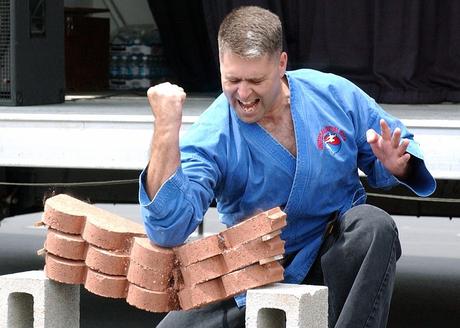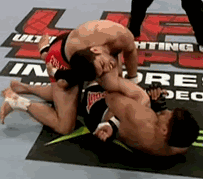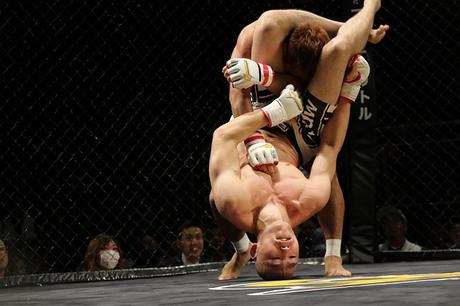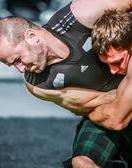Elbow Injuries
For information purposes only. Exercise at your own risk. Always consult a doctor if you sustain an injury
Anatomy
The elbow is a hinge joint that is formed by 3 bones – the humerus (upper arm), the radius (thumb side) and ulna (little finger side) of the forearm. The elbow joint flexes (bends) and extends (straightens) the arm. Elbow Injuries
Due to its structure and the number of muscles that are attached near the elbow, it is a common site for injury in MMA during both training and competition. Elbow injuries may be divided into 3 categories:
1. Single-event (acute) trauma
The most common cause of this type of injury is when adverse force is applied to the elbow joint. This can happen in MMA if, for example, an armbar is applied and you do not tap-out soon enough. An acute injury may only be soft tissue damage (muscle, tendon or ligament) or more seriously fracture or dislocation.

Dislocations occur when the arm is fully extended at the elbow and excessive force is applied to the joint forcing the bones out of position, as in an armbar.
Dislocation of the elbow may be accompanied by a fracture but always involves major damage of the elbow ligaments. With these injuries, damage to nerves and blood vessels is always a possibility so medical attention is considered urgent and essential following a dislocation. Dislocation may also be accompanied by a sharp pain and the sensation of muscle tearing at the front of the arm followed by a sudden contraction of the biceps muscle. This suggests a biceps tendon rupture and will probably require surgical reattachment of the tendon before you can return to training. So how do you know if you’ve dislocated your elbow?…well believe me you’ll know when it happens! You’ll experience immediate intense pain and swelling and your elbow won’t bend anymore!
2. Acute-on-chronic injury
Single-event trauma is the most obvious cause of injury in MMA. However, what appears to be a single-event injury to the elbow may actually be an acute-on-chronic injury, or a single-event trauma to tissue which has been made vulnerable by overuse. For example, rupture of the elbow ligaments that occurs with punching or an armbar may commonly involve ligaments that have been weakened by overuse or excessive stress during training or previous competition.
3. Multiple-repetition Injuries
Multiple repetition, overuse or chronic injuries usually occur as a result of constant overuse and typically stem from biomechanical stress (biomechanics is the science behind movement of living creatures).
These injuries may occur as a result of over-training in a particular technique or an incorrect training pattern which works against the biomechanics of an individual. Locking out during punching, weight training and armbars, excessive strain during gripping and repetitive strain at work may also lead to these sorts of problems. These problems often develop without any specific trauma. Symptoms may start slowly with burning pain on the outside or inside part of the elbow that gradually worsens over weeks or months and is worsened by gripping or lifting objects such as in Tennis and Golfer’s Elbow. It is important that you consider the cumulative impact of all stressful activity on the elbow including work, not just training. Over time, if not treated, chronic injuries can lead to permanent restrictions t
o training and competition.
Elbow Injuries – Principles of Treatment and Rehabilitation
Acute Injuries
For simple soft tissue injuries of the elbow, PRICE(MM) is the favoured approach. Protection, Rest, Ice, Compression and Elevation should be applied by the individual, then Medications and Modalities (physical treatments) should be sought from your GP or Chartered Physiotherapist. If you think your elbow is dislocated, fractured or if your bicep’s tendon has been ruptured, you need to immobilize it and go to your nearest Accident and Emergency department.

A dislocated elbow requires reducing (putting back in place) right away but do not attempt it yourself or allow anyone else who is not suitably qualified reduce it for you. An incorrectly reduced dislocation may produce additional damage to nerves and blood vessels that may affect the future use of the arm. Once it has been reduced and other injuries have been checked for, you should seek advice regarding your future rehabilitation from a Chartered Physiotherapist.
Acute on Chronic Injuries
To ensure effective treatment and rehabilitation, these injuries require aspects of both acute and chronic management approaches to be taken into account to ensure effective treatment and rehabilitation.
Chronic Injuries
As the injury may have occurred due to a biomechanical stress and dysfunction a detailed physical examination from a Chartered Physiotherapist is essential to ensure a correct diagnosis and evaluation of the nature of the problem. Treatment will usually be conservative, with emphasis on strength-building rehabilitation, addressing the biomechanical dysfunction and return to full fighting fitness.
Many chronic injuries may be prevented with good training and work habits and paying attention to your body. Never train through elbow pain, instead visit a Chartered Physiotherapist who will treat the affected arm whilst advising you on how to avoid further injuries.
With chronic injuries it is sometimes possible to find some alleviation of symptoms with changes in diet & other lifestyle changes that reduce inflammation. For example, exogenous ketones, fasting and curcumin supplementation may help for some tendinitis-related injuries. Another great tip, that many people ignore – is not avoid exercises that aggravate the injury. Barbell bicep curls for example, may make golfer’s elbow more painful. Don’t do this exercise, or switch to using resistance bands.
Rehabilitation
The principles of rehabilitation of the elbow include maintenance of general fitness, targeted rehabilitation exercises for return to combat and control of overuse. You should seek the advice of a Chartered Physiotherapist to ensure that you have a plan for your rehabilitation to work your elbow back to full function.
To maintain general fitness you should start a fitness program for all uninjured areas ASAP, with a focus on the maintenance of cardiovascular fitness for competitive athletes. Your rehab plan should include exercises to restore normal strength using progressive resistance and postural exercises that should involve the biceps and triceps as well as the entire shoulder girdle, upper back, and neck. In addition in the later stages rehab should include eccentric as well as concentric exercise and plyometric training followed by combat-specific drills (with an emphasis on proper technique), agility training and bracing as appropriate.
It’s worth pointing out however that if you are bracing or strapping (with the exception of hand wraps) a joint you should not be full contact training or considering stepping into the competitive arena.
It must also be appreciated that the power, speed and angles which occur during competition may far exceed the criteria for successful completion of rehabilitation exercise. To be ready for competition you must perform over and above what you are required to do in competition.
Return to Training/Competition
Depending on the severity of the injury, it may take many months of physical therapy for you return to full training or competition. The diversity of elbow injuries makes for a wide range of recovery and rehab times with tendon and ligament injuries often taking months to rehabilitate and a complete fracture dislocation preventing return to full MMA competition even after six to nine months of rehabilitation.

For return to full training /competition two principal factors must be considered, firstly the risk of re-injury and secondly the ability to fight/perform at a satisfactory level. These factors are often intertwined. When there is a risk of re-injury, the potential for further or permanent damage must also be considered. The criteria for return to competition after an elbow injury include restoration of normal strength, endurance, and flexibility. With repetitive injuries it is important to identify the specific activity that caused the initial injury so that activity can be avoided or training modified. Avoidance steps may include changing technique, training habits, and equipment, and the use of an elbow counterforce brace in the early stages of rehab.
This is just a brief outline of the elbow injuries you may incur during MMA training and competition and a rough guide to treatment and rehabilitation principles. If you have any specific elbow problems you will need to seek first hand advice and treatment from an experienced sports injuries Chartered Physiotherapist.
Disclaimer
This article is for the purpose of information only and it is not intended to diagnose or treat medical conditions and is not considered to be a substitute for individual medical assessment and advice.

